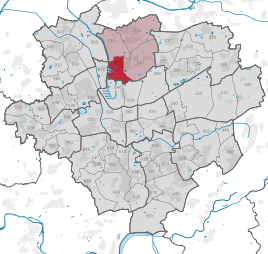Lindenhorst (Dortmund)
|
Lindenhorst
City of Dortmund
Coordinates: 51 ° 33 ′ 3 ″ N , 7 ° 27 ′ 21 ″ E
|
|
|---|---|
| Height : | 75 m above sea level NHN |
| Area : | 3.31 km² |
| Residents : | 6115 (Dec. 31, 2019) |
| Population density : | 1,848 inhabitants / km² |
| Incorporation : | June 10, 1914 |
| Postcodes : | 44145−44147, 44339 |
| Area code : | 0231 |
| Statistical District : | 14th |
|
Location of Lindenhorst in Dortmund
|
|
Lindenhorst ( Low German : Linnenhoarst) is the statistical district 14 and at the same time a district of the urban city of Dortmund . It is located in the north of Dortmund and belongs to the Eving district .
Lindenhorst was first mentioned in 1176 as Lyndenhorst . It was the ancestral seat of the Lords of Lindenhorst, who from 1296 also became the Counts of Dortmund . The ancestral seat of the noble family was located near today's Protestant church, which probably served as the manor's chapel as early as the 12th century. With the dissolution of the county of Dortmund in 1808, the place was incorporated into the territory of the Grand Duchy of Berg . Lindenhorst has only been part of the city of Dortmund since it was incorporated on June 10, 1914. The listed Johanneskirche is remarkable .
The growth of the until then exclusively agricultural town began in 1872 with the establishment of the Fürst Hardenberg colliery on the border with the Deusen district .
The sports club TuS Eving-Lindenhorst is known nationwide, from which well-known national soccer players such as Lars Ricken and Michael Zorc and the goalkeeper Stefan Klos emerged .
Today the district borders on the Dortmund-Ems Canal in the west and the Bundesstrasse 54 in the east .
Lindenhorst, like the neighboring district of Eving to the east, is one of the 13 socially disadvantaged districts of Dortmund.
geography
The place is at an altitude of 75 m above sea level. NHN .
population
On December 31, 2019 there were 6115 residents in Lindenhorst.
Structure of the Lindenhorster population:
- Share of the population under 18-year-olds: 20.6% [Dortmund average: 16.2% (2018)]
- Share of the population of at least 65-year-olds: 13.9% [Dortmund average: 20.2% (2018)]
- Proportion of foreigners: 32.1% [Dortmund average: 18.8% (2019)]
- Unemployment rate: 13.6% [Dortmund average: 11.0% (2017)]
The average income in Lindenhorst is around 10% below the Dortmund average.
Population development
| year | Pop. |
|---|---|
| 1987 | 4777 |
| 2003 | 5362 |
| 2008 | 5490 |
| 2010 | 5490 |
| 2013 | 5665 |
| 2016 | 6069 |
swell
- ↑ Population figures in the statistical districts on December 31, 2019 (PDF)
- ^ Wilhelm Schleef: Dortmund Dictionary, 1967 (PDF; 3.9 MB)
- ↑ Stephanie Reekers: The regional development of the districts and communities of Westphalia 1817-1967 . Aschendorff, Münster Westfalen 1977, ISBN 3-402-05875-8 , p. 258 .
- ↑ Population share of the under 18 year olds Statistical Atlas 2019 (PDF file)
- ↑ Population share of at least 65-year-olds Statistical Atlas 2019 (PDF file)
- ↑ Nationalities in the statistical districts on December 31, 2019 (PDF file)
- ↑ Unemployment rates according to statistical districts on June 30, 2017 ( memento of the original from June 25, 2018 in the Internet Archive ) Info: The archive link was inserted automatically and has not yet been checked. Please check the original and archive link according to the instructions and then remove this notice. (PDF file)
- www.statistik.dortmund.de



